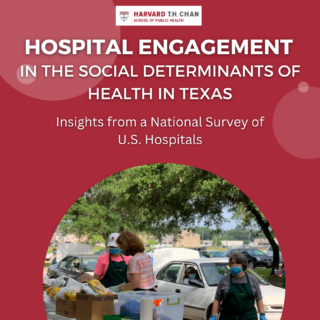Hospitals have the potential to play a significant role in addressing health inequities in the communities they serve. This is particularly true in Texas, a state that exhibits some of the starkest disparities in health care coverage, access, and health outcomes across their diverse population. The disproportionate impact COVID-19 has had on marginalized groups has brought renewed attention to improving disparities in health care and across socially vulnerable communities. Particular focus has been devoted to understanding and addressing how the social determinants of health (SDOH) have contributed to and exacerbated COVID-19-related morbidity and mortality, and other health conditions that contribute to stark differences in health outcomes and life expectancy between racial and ethnic groups.
Because of this, health systems and hospitals have started to shift more of their focus to trying to understand and address the SDOH among their patient populations. Efforts among hospitals to address these factors likely vary considerably. However, to date, there has been limited data evaluating the extent to which hospitals have engaged with SDOH of patient populations, and importantly, the specific challenges hospitals in Texas face related to this issue.
Therefore, in this first report, we examined hospital responses of a national survey from the American Hospital Association (AHA). Specifically, we used the first of its kind SDOH supplement that surveyed hospitals across three domains of SDOH engagement. The three domains include: 1) screening of social needs, 2) programs and interventions to address SDOH, and 3) community partnerships with external partners to address SDOH.
Nationwide results across US hospitals were recently published in JAMA Health Forum. Harvard researchers found that there is wide variability in the number of strategies hospitals report using to address SDOH. Of particular concern was the finding that hospitals that disproportionately care for more vulnerable populations (including safety-net hospitals, critical access hospitals, and rural hospitals) are not doing more, and in some cases doing much less, to address the social needs of their patients and their communities, including implementation of programs and interventions to address SDOH and the extent to which they participate in community partnerships. Below, we review in further detail the Texas-specific results across 346 hospitals that responded to the survey. Importantly, we analyze results by different hospital characteristics and also compare how Texas’ hospitals fared relative to other hospitals across the country.
Acknowledgements:
This report was prepared by researchers from the Harvard T.H. Chan School of Public Health in collaboration with the Episcopal Health Foundation. Contributors to report include Aaron Hedquist, Gaby Aboulafia, Ciara Duggan, and Jose Figueroa from HSPH and Shao-Chee Sim and Briana Martin from EHF.
